By Mike Tanner, Photos by Mike Tanner
Imagine if Goldilocks had been a traveling golfer. She might have looked at Myrtle Beach’s cornucopia of golf courses and said, “Too many.” She might have considered the paucity of choices at typical resorts and said, “Too few.” But if she had looked at the half-dozen courses that comprise the Outer Banks Golf Association in North Carolina, she likely would have pronounced them, “Just right!”
We recently visited the Outer Banks in early October and the weather on North Carolina’s coast was just right too. In the wake of a passing low pressure system, the conditions for golf rapidly improved from overcast to blue skies and bright sunshine that infused the proceedings with a mellow atmosphere.
Our base camp was the Club Cottage at Kilmarlic, which is located just a few minutes from the bridge connecting the mainland and the beach. Three of the six courses we played are located on the mainland and three on the narrow, sandy stretch of land that separates the Atlantic Ocean from shallow coastal sounds. They’re all within an easy drive from one another, so our lodgings were perfectly situated.
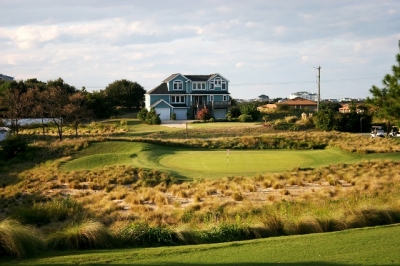 |
| The drop shot, par-3 ninth hole at Sea Scape Golf Links. |
Kilmarlic is also where we played our first round upon arrival on the Sunday just after the US team had handed the Ryder Cup back to their opponents on the European squad. No stranger to championship golf tournaments, Kilmarlic has twice hosted the North Carolina Open, in 2004 and 2009.
Carved from a thick stand of mature hardwood and pines trees, and dotted with numerous ponds and low-lying wetlands, Kilmarlic offers a picturesque version of coastal Carolina golf. The Tom Steele-designed layout boasts a slope rating of 144 from the tournament tees, but we opted to play it at 6,001 yards, which proved to be challenge enough for our rusty game.
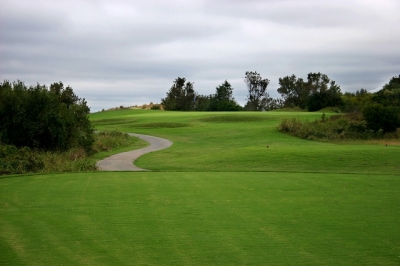 |
| The target is only 22 yards deep on Nags Head Golf Links\' par-3 17th hole. |
After a series of friendly holes to begin your round, things get serious on the 4th hole, a par-5 that asks you to carry your shot over a wide expanse of wetlands to reach the green in two or to skirt the danger with a lay-up shot that leaves you with a short iron to the putting surface. Two holes later, a long par-4 hole that plays 487 yards from the tips ratchets up the degree of difficulty.
The first standout hole on the back nine is a fishhook-shaped par five that offers a risk-reward second shot over a marshy hazard, but it’s the five concluding holes at Kilmarlic that provide the most vivid memories.
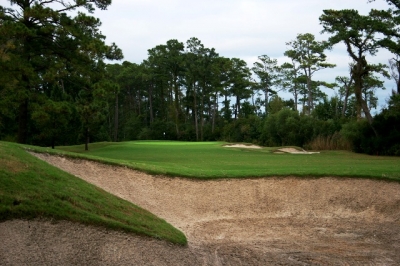 |
| A deep bunker guards the 15th fairway at Kilmarlic Golf Club. |
The short par-four 14th hole features a long prospect through the trees toward the Albemarle Sound, which lies beyond the green. Wriggling between wetlands to the left and a margin of trees to the right, the par-four 15th hole demands accuracy from tee to green. The penultimate hole is a par-3 offering the choice of a daunting, all-carry tee shot over a watery hazard or a safer play to a bail-out area right of the green. Water threatens from the left on the 18th hole, which concludes in front of the clubhouse’s back patio and offers the perfect vantage point for watching sunsets over Kilmarlic’s bracing back nine.
Just a few miles up the road from Kilmarlic, sister courses The Carolina Club and The Pointe Golf Club offer wide-open vistas and generally flat terrain. Both courses are ideally suited for the first round of a golf trip, allowing you to find your full swing and get a feel for your putting stroke.
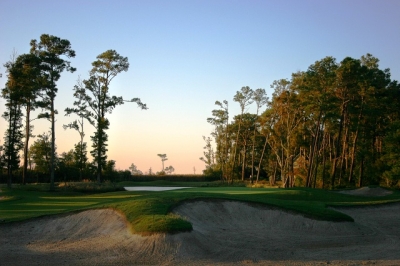 |
| A long vista on the short par-four 14th hole at Kilmarlic Golf Club. |
A Russell Breeden design, The Pointe’s A-1 bentgrass greens are renowned for their firmness and speed. They serve as a terrific equalizer to the course’s relative lack of length, just 6,343 yards from the back tees.
A dogleg right that bends around a large pond eases you into your round and the front nine includes glimpses of Currituck Sound on the sixth and seventh holes. The par-4 twelfth hole features a drive over a wetland area that’s more of a visual threat than it is a danger to your golf ball.
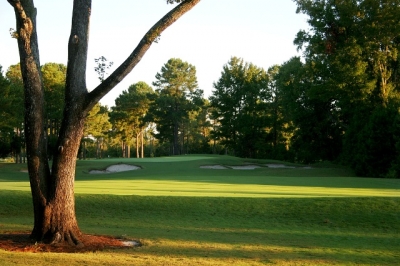 |
| Mature hardwood and pine trees line fairways at Kilmarlic Golf Club. |
Situated in a corner of the property near the main road, the final four holes at The Pointe include a bite-off-as-much-as-you-dare tee shot on the par-four 15th hole and a testy little short par-4 at the 16th hole. The finisher, a gentle dogleg-left par-5, defends par with a long, narrow green that demands pinpoint accuracy with your approach shot.
Over at The Carolina Club, architects Russell Breeden and Bob Moore are the authors of a player-friendly track that can be stretched out to just under 7,000 yards from the back tees or played at 6,544 from the gold tees and 6,102 from the blue tees.
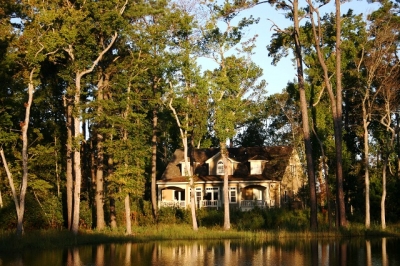 |
| The Club Cottage at Kilmarlic as seen from the 18th fairway. |
The first five holes allow you to get into a nice rhythm. You’ll discover if you’re playing the proper set of tees when you get to the par-5, sixth hole. A narrow cross hazard bisects the fairway, offering you the option of hitting your tee shot over it or hearing your opponents clucking like chickens if you lay up short of the low-lying wetlands.
Immediately following, players make a 180º turn and behold a par-3 featuring an island green. Water also comes into play on a number of succeeding holes, most notably on the 9th and 18th holes.
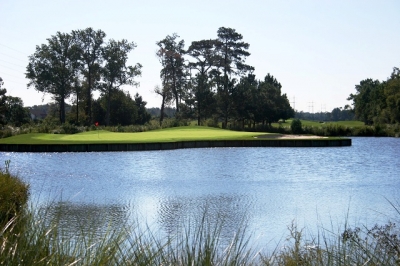 |
| Hit your target or reload at The Carolina Club's island green 7th hole. |
Both are par-fives and both challenge you to control your tee shot. There’s water down the left side of the ninth fairway and water on both sides of the landing area on eighteen. The ninth is particularly treacherous with water menacing the landing area for your second shot and fronting the green as well.
Whether you try to squeeze in 36 holes a day or are content to finish your day after one round, you’re bound to work up an appetite. Fortunately for hungry golfers, there are plenty of good eats to choose from on the Outer Banks.
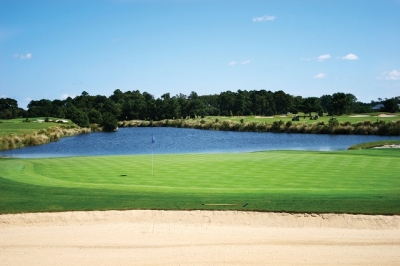 |
| Looking back from behind the 17th green at The Carolina Club. |
North Carolina is justly famous for barbecue and we sampled a tasty selection of spicy-sauced pork, beef and chicken, plus a slew of flavorful side dishes from the Currituck BBQ Co. on our first night. The hearty meal was a welcome treat following our opening round at Kilmarlic on a cool, blustery and misty afternoon.
As dawn broke the next morning we set off across the sound to Nags Head Golf Links, a Bob Moore design that’s short on yardage, but long on challenge. The wind was still up, but this is the Outer Banks, so you can’t expect still air.
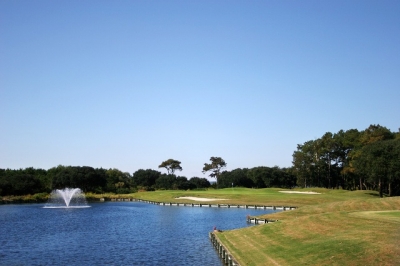 |
| You've got to trust your swing on the sixth hole at The Currituck Club. |
Like all three of the courses we played on the beach side, Nags Head is laid out in a figure eight routing, clockwise going out and counter-clockwise coming back. In theory, the wind helps as much as it hurts, but it doesn’t always seem to work like that in practice.
We played the course at just 5,717 yards with a slope rating of 129. The first three holes lead you away from the clubhouse before the par-4 fourth hole brings you to the edge of the Albemarle Sound. The par-5 fifth hole parallels the sound and then the course veers inland before returning to the shoreline again for the very testing ninth hole, where no mistake off the tee goes unpunished and the approach shot over some rough, scrubby growth doesn’t reduce the degree of difficulty.
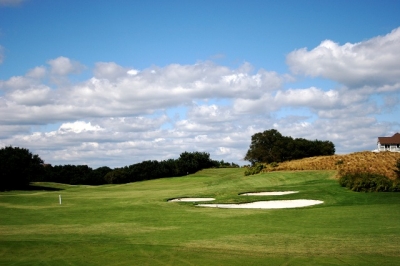 |
| A beautiful use of the terrain at The Currituck Club's par-4 12th hole. |
The back nine winds through some housing before turning toward the sound again on the short par-4 fourteenth hole. The concluding series of holes includes two par-3 holes that play in opposite directions thanks to some nifty routing. The last hole, a par-5 with water all down the right side and a gradually narrowing landing area for tee shots, provides one last opportunity for a birdie if your drive threads the needle and your second shot finds the smallish, two-tiered green.
Our round at Nags Head Golf Links that day was the opening course of a very full sampling of the gamut of activities on the Outer Banks. We grabbed a quick lunch overlooking the sound at Sugar Creek Seafood Restaurant, where the traditional Outer Banks clam chowder—a clear broth chock-full of tender clams—was the highlight of our meal.
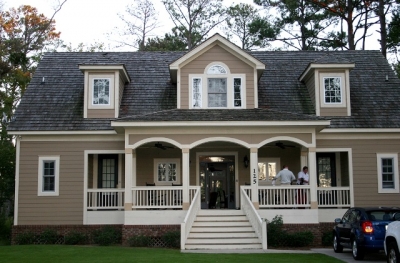 |
| A most welcoming home away from home at Kilmarlic Golf Club. |
Then we drove up the road to visit the Wright Brothers National Memorial in Kill Devil Hills. The wind was still up as we looked over the granite boulder that commemorates the first flight and the stone markers that indicate the courses of all four flights that took place on December 17, 1903. It’s truly awe-inspiring to realize that in less than 100 years, humans would go from a 120-foot powered flight in a fragile, cloth-covered wooden biplane in North Carolina to a walk on the moon’s surface.
On the way back to our accommodations at Kilmarlic we stopped at Barefoot Bernie’s Tropical Grill & Bar in Kitty Hawk for supper. The comfortable atmosphere, complete with TVs on every wall tuned to sports programming, made us feel welcome and a couple of glasses filled with Fat Tire Ale helped ease the sting of our windblown round of golf that morning.
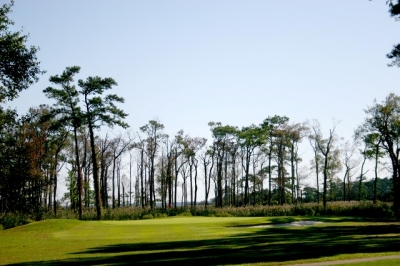 |
| The Currituck Sound beckons from beyond The Pointe's par-3 seventh hole. |
Just down the road from Bernie’s is where you’ll find Sea Scape Golf Links, the one and only golf course designed by Art Wall. “Art who?” you might well ask. He was the 1959 Masters champion—one of 14 titles in his PGA TOUR career—making birdies on five of the last six holes to shoot a final-round 66 and emerge victorious.
Apparently, Art was not a proponent of the “start-em-off-easy” school of course design. The first hole is the No. 1 handicap hole on the course, with a thick patch of wiry grass between the teeing ground and fairway. Like a rollercoaster’s first big drop, once you’re past that gulp-inducing prospect, the ride is a lot of fun.
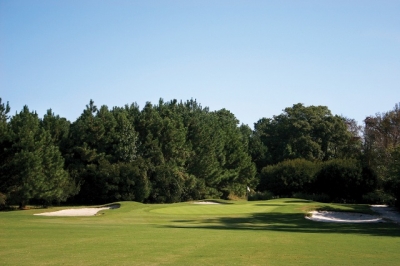 |
| The 11th green occupies a cozy corner of The Pointe Golf Club. |
Sea Scape offers rolling terrain among the sand dunes with plenty of elevation changes and looks that run the gamut from an open, links-like feel to corridors buffered by maritime forest. Players had better be able to summon a draw on the dogleg-left, fifth hole, appropriately named “Roon the Ben.” The last two holes on the front nine feature a large sand dune formation that holds the sharply elevated eighth green and the teeing area for the drop-shot, par-3 ninth hole.
Standout holes on the back nine include the par-five eleventh hole with a plateau green offering a view of the ocean, the cozy par-3 thirteenth hole called “Little Nip” and the entire series of four holes that follow. The final hole is an uninspired par-4, but its shortcomings are more than made up for by the thoroughly enjoyable 17 holes that precede it.
There was a finale of a different sort awaiting us as we topped off our day of golf a couple of blocks away from Sea Scape with dinner at Ocean Boulevard. Housed in a former hardware store, this fine dining restaurant offers a seasonally changing menu with many ingredients sourced from local purveyors of seafood, meat, fruits and vegetables.
Our visit to the beachside golf courses concluded in Corolla at The Currituck Club, a resort-style layout designed by Rees Jones and rated as one of the “Ten Best New Places You Can Play” by GOLF magazine after opening in 1996.
The course traverses an array of coastal terrain from the first tee high on an immense sand dune to the finishing holes along Currituck Sound. The outgoing nine holes loop in a clockwise direction around a lake at holes four and five before turning to parallel the sound on the seventh and eighth holes, and then returns to the ninth green, which is tucked next to the magnificent clubhouse atop the aforementioned sand dune.
The incoming nine features a charming dogleg right, par-4 hole at number 12, with an elevated green benched into the side of a long sand ridge. A classic short par-4 at number 14 links the first half of the back nine to the four finishing holes, which begin with the par-3 fifteenth hole, one of The Currituck Club’s most-often photographed holes.
Although it isn’t visible from the course in daylight hours, the nearby Currituck Beach Lighthouse has signaled a warning beacon to mariners since it was first illuminated in 1875. After stopping for a hearty lunch at the North Banks restaurant in the Tim Buck II shopping center, we visited the restored national landmark and the grounds around it. The view from the top is spectacular and worth every one of the 214 steps it takes to get there.
Literally the high point of our sojourn to the Outer Banks, the lighthouse could also serve as a beacon for traveling golfers. From golf courses offering a variety of looks and an array of challenges to dining for every budget and plenty of interesting activities and attractions off the golf course, the Outer Banks is a “just right” destination.
Details:
seascapegolf.com
| Related Links | Comments on this article? | |
|
Maryland National Golf Club Hollow Creek Golf Club Rocky Gap Resort PB Dye Golf Club in Ijamsville Whiskey Creek Golf Club |
E-mail Jeff Rendall, Editor: jrendall@golftheunitedstates.com |











